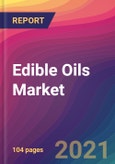This report titled “Edible Oils Market - Growth, Future Prospects, and Competitive Analysis, 2021 - 2029” offers strategic insights into the trends in edible oils market along with the market size and forecast for the duration 2019 to 2029. The said research study incorporates in-depth analysis of multiple market segments based on type and geographical distribution.
The global edible oils market is becoming increasingly competitive with growing new products by market players to reach full capabilities and gain international footprint. In addition, several players are also focused on developing their niche products in the market. Rapid growth of this market has also resulted in creating further skilled job opportunities in major hubs spread across North America, Asia Pacific and Europe.
Based on type, the global edible oils market is categorized into palm oil, sunflower oil, soyabean oil, olive oil, corn oil, canola oil, and others. Market size and forecast for all the considered segmentation is presented in this report for the period 2019-2029 (US$ Mn) along with their respective CAGRs for the forecast period 2021-2029 (Value %).
This product will be delivered within 2 business days.
The global edible oils market is becoming increasingly competitive with growing new products by market players to reach full capabilities and gain international footprint. In addition, several players are also focused on developing their niche products in the market. Rapid growth of this market has also resulted in creating further skilled job opportunities in major hubs spread across North America, Asia Pacific and Europe.
Based on type, the global edible oils market is categorized into palm oil, sunflower oil, soyabean oil, olive oil, corn oil, canola oil, and others. Market size and forecast for all the considered segmentation is presented in this report for the period 2019-2029 (US$ Mn) along with their respective CAGRs for the forecast period 2021-2029 (Value %).
In terms of geographical distribution, the global edible oils is studied for five major regions namely, North America, Europe, Asia-Pacific, Latin America, and Middle East and Africa. Market size and forecast for each regional and country-level market are included in the report for the considered periods. To further elucidate, the geographical distribution of the global edible oils market is performed as follows:
- North America
- U.S.
- Canada
- Europe
- U.K.
- Germany
- Rest of Europe
- Asia-Pacific
- Japan
- China
- Rest of Asia-Pacific
- Middle East and Africa
- Latin America
On the basis of type, the edible oils market is categorized into following types:
- Palm Oil
- Sunflower Oil
- Soyabean Oil
- Olive Oil
- Corn Oil
- Canola Oil
- Others
On the basis of geography, the global edible oils market is segmented into following categories
- North America
- Europe
- Asia Pacific
- Middle East & Africa (MEA)
- Latin America (LATAM)
This product will be delivered within 2 business days.
Table of Contents
1. Preface
2. Executive Summary
3. Global Edible Oils Market Dynamics
4. Global Edible Oils Market Size (US$), By Type, 2019 - 2029
5. Global Edible Oils Market Size (US$), By Geography, 2019 - 2029
6. Company Profiles
Companies Mentioned
- Adani Wilmar Ltd
- Associated British Foods Plc.
- Bunge Alimentos S.A.
- Fuji Vegetable Oil Inc.
- Archer Daniel Midland Company
- The Adams Group Inc.
- Cargill Incorporated
- Ruchi Soya Industries Ltd.
- Olympic Oils Ltd.
- American Vegetable Oils Inc.








